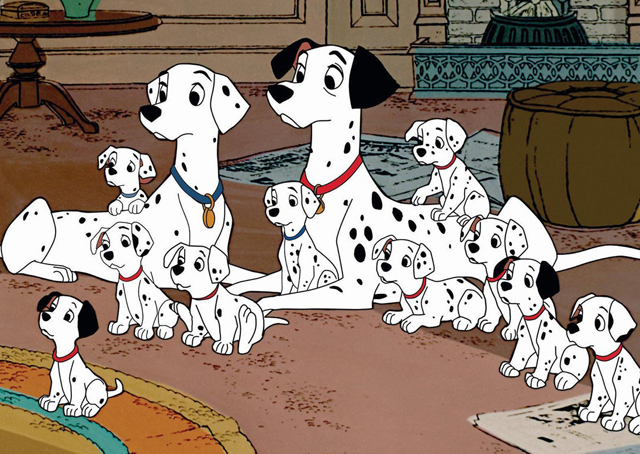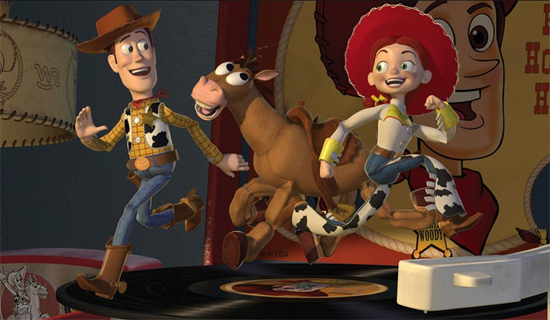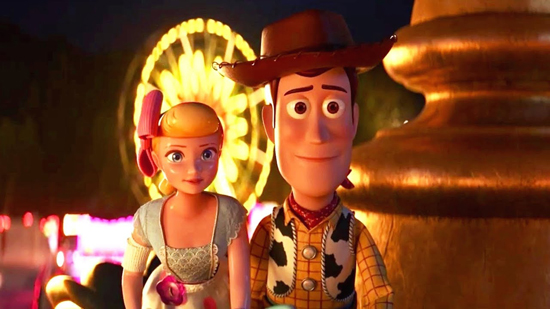
Everybody’s childhood was no doubt influenced by the movies they saw. Whether they were vague memories or vivid, we can recall the feelings we had when we first saw some of our favorite movies, and if you are able to recall a first time viewing that happened in your early childhood, than that means the movie must be extra special to you. For me in particular, the fact that I can remember what the first films I ever saw in a theater were to this day is probably why I am the way that I am. Movies, even at a super young age, grabbed a hold onto me and didn’t let go. It propelled me to explore film more deeply, led me to pursue filmmaking as a career, took me to film school, and has kept me active in writing about movies on this very site. It all started with my mother taking me to the movie theater to watch films from the likes of Disney, Spielberg, Don Bluth and anything else that was age appropriate. Exact memories may be buried too deep now to be vividly remembered today, but I do know for sure what that first movie was that I saw in a theater. It was the Walt Disney classic, 101 Dalmatians (1961). Now reaching it’s 60th Anniversary this year, 101 Dalmatians was already an established hit before I was born. But, because this was the early 1980’s, and home video hadn’t come into it’s own just yet, studios like Disney were continuing a long standing tradition of re-releasing their past classics into theaters again, roughly every 7-10 years. 101 Dalmatians had already enjoyed a couple of these re-releases, each of them wildly successful before it came out just in time for me to see it. I was only 3 years old when my Mom finally took me to the theater for the first time in December of 1985, and unbeknownst to her, she was about to open up her little boy’s world to something that would define the rest of his life.
But, why 101 Dalmatians. It’s possible that any movie would have awakened the inner cinephile in my 3 year old sensibilities. What made Dalmatians so unique that it stuck with me all these years later. Probably as I’ve put together the pieces of the movie’s place within the whole grand story of the Disney Company’s history, as well as with Hollywood in general, 101 Dalmatians becomes a more fascinating oddity that more than ever captures the imagination even after multiple viewings. I am certainly not alone in holding up Dalmatians with such high regard. The film, with all of it’s multiple theatrical releases, ranks as one of Disney’s highest grossing movies ever; with a lifetime gross of just over $900 million adjusted for inflation. In it’s 1995 re-release alone netted it $71 million, which is better than most first runs for many films, animated or not. One thing I have learned about the film in it’s long history that I find fascinating is that the success was even a surprise to Walt and company. Disney was coming off of a decade of huge gambles and many financial headaches. Disneyland had opened to mixed results in 1955, only just finally turning a profit at the beginning of the new decade. The studio began to grow with the successes of Cinderella (1950), Peter Pan (1953) and Lady and the Tramp (1955), but the animation department fell into the red again as Sleeping Beauty (1959) went massively over-budget and over-schedule. The fact that Sleeping Beauty soaked up so much of Disney’s time and money led Walt to make the unfortunate choice put a lot of his future big plans on hold, so that his company could recoup. Sadly, time would run out on Walt in the 60’s, and a lot of those plans would never come to pass. Instead, he had to reorganize and keep his company going with projects that in many ways ran contrary to his own personal tastes.
On the heels of Sleeping Beauty’s premiere, Walt greenlit 101 Dalmatians as his next feature, which would be a wild departure from the movies that he was known for. Based on the children’s novel by British author Dodie Smith, 101 Dalmatians did not have a fairy tale, medieval setting that so many of Disney’s past animated features took place in. Instead, the story took place in contemporary London, England, in a world not too set apart from our own. It was probably the first ever Disney movie to feature a TV set within it for example. Not only did the setting feel more modern for Disney, but the visual design of the movie was altered to reflect this change. For most of the post-war years, the Disney style became very refined and naturalistic. Starting with Sleeping Beauty, and continuing through Dalmatians, the visual style of Disney became rougher and more graphic. Gone were the clean, fine lines of the drawings, and in it’s place were characters and environments that looked more like they were etched roughly out of pencil. This is partially due to the fact that in order to save on costs, Disney had embraced a new Xerox process to transfer the animator’s drawings right off the page on onto the animation cel. This was a process that made the animator’s rough pencil drawings translate for more definitively into the final image, which gave the animation that rough, textured look. The background likewise were designed with this new style in mind, drawing in more abstract inspiration from ad artwork from the time, and it would dramatically change the way Disney animation would look for many years after. There was no doubt about it, 101 Dalmatians would be an entirely different movie for Disney than what they had made before. And in typical Disney fashion, it would be the movie that nobody expected big things out of that would have the bigger impact in the long run.
Walt most likely approved of what 101 Dalmatians turned out to be, but it is clear that it wasn’t exactly something that he held up as one of his proudest achievements either. Unlike Snow White (1937), Cinderella (1950), and Sleeping Beauty (1959), you’ll be hard pressed to find any media out there at all of Walt Disney speaking about what 101 Dalmatians meant to him. It was one of the biggest hits of his career, and he barely talked about it. It’s probably because he never had a deep personal investment in the movie the same way that he did with Sleeping Beauty. Beauty was meant to be his crowning achievement as a filmmaker, and when it disappointed at the box office after costing so much, it hit Walt personally. Seeing another one of his movies that he had less investment in personally far exceed it in success probably even rubbed salt in his wounds. But again, Walt never openly disdained Dalmatians either, like say he did for Alice in Wonderland (1951). Dalmatians probably gave him the financial cover to make his next big project (Mary Poppins, for example) so he could have appreciated that it did that. Despite what he thought of the movie itself, the film was embraced by fans of all ages pretty much immediately. Audiences and critics lauded the unique visual style of the movie and it’s charming story. In terms of the story itself, it is amazing how well it holds together when you take into account that it stars literally 101 individual dogs. It probably works as well as it does, because of the theme of family and the lengths that we go to keep those bonds together. Whether it’s between a man and his pet dog, a couple welcoming new life into the world, or a community coming together to help one another, the universal theme of familial love rings out through the whole movie.
But what also defines 101 Dalmatians as an all time classic is that it features what many consider to be one of the greatest villainesses in cinema history. Apart from the titular Dalmatians themselves, the movie’s other star attraction is the incredibly evil and diabolical Cruella De Vil. Cruella is an icon in every sense, with her billowing fur coat and her trademark white and black hairstyle (not to mention a trail of green cigarette smoke that follows her everywhere), she just pops right off of the screen. Certainly she was meant to be a pointed satire of the fashionistas of the era, with personalities that often were just as monstrous, but her presence in the film takes on an even more sinister purpose. Her desire is to not only take Dalmatian puppies away from their rightful owners and parents, but to also kill and skin them for their fur, just because she’s obsessed with making a spotted Dalmatian coat. This demented level of animal cruelty makes her an especially memorable baddy in the Disney canon, and her outsized personality even further cements her within the halls of Disney Villain infamy. Voiced with incredible zeal by veteran actress Betty Lou Gerson, and animated by Disney Legend Marc Davis (in what would be his final film assignment before moving to the Theme Parks division), Cruella immediately jumps onto the screen in her opening moments. She intrudes on the Radcliffe home shouting “Anita, Dahling,” and spend the next scene lording over all around her, like a storm passing through the neighborhood. If there was ever a textbook example of how to perfectly introduce your villain into a story, Cruella’s introduction scene would be it. And throughout the movie, she commands every moment she’s on screen. Capable of being funny and menacing at the same time, you don’t find more entertaining villains than Cruella De Vil, and she is absolutely one of the reasons why the movie has maintained a dedicated following over the years.
One great indicator of the film’s long held popularity is that it has spawned so many renewals over the years. Long before it became a trend at the Disney studio, 101 Dalmatians became the first Disney classic to receive a live action remake. With a screenplay by John Hughes, the 1996 remake focuses much more on the human characters of Roger and Anita Radcliffe (played by Jeff Daniels and Joely Richardson, respectively) with the dogs themselves being speechless this time around. Of course, with the Dalmatians taking more of a backseat, it allows for the other star of the film to shine brighter, which would be Cruella herself. The remake’s biggest strength was in casting an actress like Glenn Close for the part. Close delivers a delightfully campy performance that brings out all the potential of the character into live action, and in many ways helps to elevate the film overall, which sadly sees Hughes relying a little too heavily on his Home Alone (1990) style antics, which is not a good fit. Still, the remake was a big success, earning Close a Golden Globe nomination in the process and even led to creation of a sequel, 2000’s 102 Dalmatians, also starring Glenn Close. In the years after, 101 Dalmatians also inspired a couple of animated series, as well as an animated sequel that went straight to DVD like so many others from Disney at the time. And to show that the original movie still has legs to this day, we are about to get the Cruella origin movie this summer with Oscar-winner Emma Stone starring as the titular villainess. All of this is pretty incredible, considering that it was a movie that was originally believed to be a cheap filler in Disney’s production schedule that Walt himself didn’t really care much for. But like other B-Movies in Disney’s long history, like Dumbo (1941) and The Lion King (1994) never underestimate the power of a good story.
So what does the movie mean to me personally. Well, I don’t know exactly how it took a hold of me when I first saw it; I was only 3 after all. But I have always remembered that it was the first movie I ever saw in the theater. And as a small child, I was keenly aware of how Disney stood out from everything else I would watch. I knew which movies I saw were Disney films and which ones were not, without even knowing where those other movies came from. It’s probably because I had such a distinct picture in my mind of what a certain type of movie should be, and how Disney had a style that stood out from the rest. I knew very early on that Walt Disney and Don Bluth were two very different people who made very different movies, and I could tell their movies apart from one another. Most kids under the age of 10 probably didn’t have that kind of brand recognition developed so early on, because so many of the kids I grew up with just thought the name Disney was synonymous with all animated movies. I was just always born to be a film buff, and I recognize that it probably started with my obsessions over Disney animation back when I was very little. I was commonly referred to as the Disney kid at school, but that was partly due to the fact that I had yet to broaden my knowledge of cinema beyond just what the Disney had been making. Today, I am indeed more than just that Disney kid, though it’s still there at the core of identity. And I always return back to 101 Dalmatians as the genesis of my journey through cinematic life. It’s no longer my favorite movie, and at times I don’t even recognize it as my favorite Disney movie anymore. But, it is still held in special regard as the movie that started it all for me.
With the movie now hitting that 60 year benchmark, it is interesting to see how strongly it has managed to hold up all these years. What is special about it is the fact that it broke new ground for both Disney and animation in general. It broke the mold with how an animated film should look, with it’s modern aesthetic and rough, sketchy animation, thanks to the new Xerox based transfer. It also endeared so many people to these characters throughout the years. How many dog owners do you think have named their pets Pongo or Perdita, after the Dalmatian parents at the center of the film. The movie also effectively vilified the practice of animal slaughter for the sake of fashion. I don’t know if the movie directly led to the downfall of the fur trade, but if it did move the fashion world in that direction, than it’s something that the movie should definitely be honored for. And of course, Cruella still remains as popular a Disney villain as ever. I hope the upcoming movie doesn’t go the Maleficent (2014) route and tries to find a sympathetic side to the character. Cruella is defined by one of the most dastardly deeds a human being is capable of, and to diminish that is to be dismissive of a real world problem that should not be glorified. Of course, the effect it has had on this one film fanatic is immeasurable. Seeing it for the first time on the big screen led to me cuddling at bed at night with a stuffed Dalmatian doll as a little child, to sleep overs at my friends’ houses in my 101 Dalmatians sleeping bag as a kid, to buying the movie over and over again on different formats as a teen, to finally watching the movie again on the big screen as an adult on Hollywood Boulevard at the El Capitan theater in Los Angeles. 101 Dalmatians and I go way back, and it has always been a part of my journey deeper into the business of film. And with the movie making it to a momentous 60th year, while also still maintaining the same level of popularity this whole time, I find it hard not to celebrate all those years together, particularly the ones that mattered so much to me.






